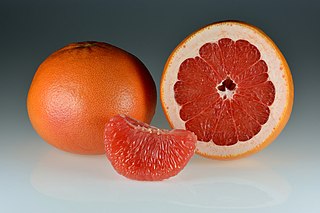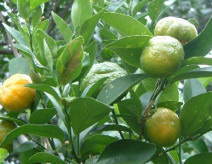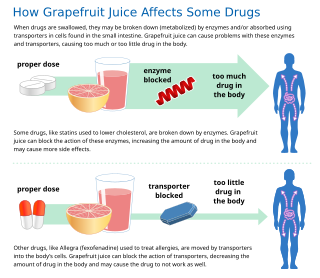Related Research Articles

Citrus is a genus of flowering trees and shrubs in the family Rutaceae. Plants in the genus produce citrus fruits, including important crops such as oranges, mandarins, lemons, grapefruits, pomelos, and limes.

The grapefruit is a subtropical citrus tree known for its relatively large, sour to semi-sweet, somewhat bitter fruit. The flesh of the fruit is segmented and varies in color from pale yellow to dark red.

A clementine is a tangor, a citrus fruit hybrid between a willowleaf mandarin orange and a sweet orange, named in honor of Clément Rodier, a French missionary who first discovered and propagated the cultivar in Algeria. The exterior is a deep orange colour with a smooth, glossy appearance. Clementines can be separated into 7 to 14 segments. Similar to tangerines, they tend to be easy to peel. They are typically juicy and sweet, with less acid than oranges. Their oils, like other citrus fruits, contain mostly limonene as well as myrcene, linalool, α-pinene and many complex aromatics.

A lime is a citrus fruit, which is typically round, lime green in colour, 3–6 centimetres (1.2–2.4 in) in diameter, and contains acidic juice vesicles.

Flavonoids are a class of polyphenolic secondary metabolites found in plants, and thus commonly consumed in the diets of humans.

Polyphenols are a large family of naturally occurring phenols. They are abundant in plants and structurally diverse. Polyphenols include phenolic acids, flavonoids, tannic acid, and ellagitannin, some of which have been used historically as dyes and for tanning garments.

The pomelo, also known as a shaddock, is the largest citrus fruit. It is an ancestor of several cultivated citrus species, including the bitter orange and the grapefruit. It is a natural, non-hybrid, citrus fruit, native to Southeast Asia. Similar in taste to a sweet grapefruit, the pomelo is commonly eaten and used for festive occasions throughout Southeast and East Asia. As with the grapefruit, phytochemicals in the pomelo have the potential for drug interactions.

Limonoids are phytochemicals of the triterpenoid class which are abundant in sweet or sour-scented citrus fruit and other plants of the families Cucurbitaceae, Rutaceae, and Meliaceae. Certain limonoids are antifeedants such as azadirachtin from the neem tree.

Juicing is the process of extracting juice from plant tissues such as fruit or vegetables.

The açaí palm, Euterpe oleracea, is a species of palm tree (Arecaceae) cultivated for its fruit, hearts of palm, leaves, and trunk wood. Global demand for the fruit has expanded rapidly in the 21st century, and the tree is cultivated for that purpose primarily.

Citrus depressa (Citrus × depressa, formerly C. pectinifera, Okinawan: シークヮーサー/シークァーサー, romanized: shiikwaasa, Japanese: ヒラミレモン, romanized: hirami remon or シークヮーサー, shiikwāsā, in English sometimes called shiikuwasha, shequasar, Taiwan tangerine, Okinawa lime, flat lemon, hirami lemon, or thin-skinned flat lemon, is a small citrus fruit often harvested and used when green, rich in flavonoids and native to East Asia.

Grapefruit juice is the juice from grapefruits. It is rich in vitamin C and ranges from sweet-tart to very sour. Variations include white grapefruit, pink grapefruit and ruby red grapefruit juice.

Naringenin is a flavanone from the flavonoid group of polyphenols. It is commonly found in citrus fruits, especially as the predominant flavonone in grapefruit.

Naringin is a flavanone-7-O-glycoside between the flavanone naringenin and the disaccharide neohesperidose. The flavonoid naringin occurs naturally in citrus fruits, especially in grapefruit, where naringin is responsible for the fruit's bitter taste. In commercial grapefruit juice production, the enzyme naringinase can be used to remove the bitterness (debittering) created by naringin. In humans naringin is metabolized to the aglycone naringenin by naringinase present in the gut.

Hesperidin is a flavanone glycoside found in citrus fruits. Its aglycone is hesperetin. Its name is derived from the word "hesperidium", for fruit produced by citrus trees.

Some fruit juices and fruits can interact with numerous drugs, in many cases causing adverse effects. The effect is most studied with grapefruit and grapefruit juice, but similar effects have been observed with certain other citrus fruits.

Flavonols are a class of flavonoids that have the 3-hydroxyflavone backbone. Their diversity stems from the different positions of the phenolic –OH groups. They are distinct from flavanols such as catechin, another class of flavonoids, and an unrelated group of metabolically important molecules, the flavins, derived from the yellow B vitamin riboflavin.

Phenolic compounds—natural phenol and polyphenols—occur naturally in wine. These include a large group of several hundred chemical compounds that affect the taste, color and mouthfeel of wine. These compounds include phenolic acids, stilbenoids, flavonols, dihydroflavonols, anthocyanins, flavanol monomers (catechins) and flavanol polymers (proanthocyanidins). This large group of natural phenols can be broadly separated into two categories, flavonoids and non-flavonoids. Flavonoids include the anthocyanins and tannins which contribute to the color and mouthfeel of the wine. The non-flavonoids include the stilbenoids such as resveratrol and phenolic acids such as benzoic, caffeic and cinnamic acids.

The lemon is a species of small evergreen tree in the Citrus genus of the flowering plant family Rutaceae. The lemon is a hybrid of the citron and the bitter orange. Its origins are uncertain, but some evidence suggests lemons originated during the 1st millennium BC in what is now northeastern India.

6',7'-Dihydroxybergamottin is a natural furanocoumarin found in pomelos, grapefruits, and sour oranges, in both the peel and the pulp. Along with the chemically related compound bergamottin, it is believed to be responsible for a number of grapefruit–drug interactions, in which the consumption of citrus containing one or both of these compounds affects the metabolism of a variety of pharmaceutical drugs.
References
- 1 2 3 4 5 6 7 8 von Woedtke T, Schlüter B, Pflegel P, Lindequist U, Jülich WD (June 1999). "Aspects of the antimicrobial efficacy of grapefruit seed extract and its relation to preservative substances contained". Pharmazie. 54 (6): 452–6. PMID 10399191.
- 1 2 Ganzera M, Aberham A, Stuppner H (May 2006). "Development and validation of an HPLC/UV/MS method for simultaneous determination of 18 preservatives in grapefruit seed extract". J. Agric. Food Chem. 54 (11): 3768–72. doi:10.1021/jf060543d. PMID 16719494.
- ↑ Dowling, Curtis F.; Morton, Julia Frances (1987). Fruits of warm climates. Miami, Fla: J.F. Morton. pp. 152–8. ISBN 978-0-9610184-1-2.
- ↑ Michael Quinion. World Wide Words: Questions & Answers; Grapefruit. 2009.
- ↑ Fellers PJ, Nikdel S, Lee HS (August 1990). "Nutrient content and nutrition labeling of several processed Florida citrus juice products". J Am Diet Assoc. 90 (8): 1079–84. doi:10.1016/S0002-8223(21)01704-1. PMID 2380455. S2CID 25833812.
- ↑ Worwood, Valerie Ann (1991). The complete book of essential oils and aromatherapy . Novato, Calif: New World Library. ISBN 978-0-931432-82-8.
- ↑ Cerda JJ, Robbins FL, Burgin CW, Baumgartner TG, Rice RW (September 1988). "The effects of grapefruit pectin on patients at risk for coronary heart disease without altering diet or lifestyle". Clin Cardiol. 11 (9): 589–94. doi: 10.1002/clc.4960110902 . PMID 3229016. S2CID 45520617.
- 1 2 3 Scott Gravura (10 March 2016). "Not natural, not safe: Grapefruit seed extract". Science-based Medicine. Retrieved 17 November 2018.
- ↑ Arthington JD, Kunkle WE, Martin AM (July 2002). "Citrus pulp for cattle". Vet. Clin. North Am. Food Anim. Pract. 18 (2): 317–26, vii. doi:10.1016/S0749-0720(02)00023-3. PMID 12235663.
- ↑ Cvetnić Z, Vladimir-Knezević S (September 2004). "Antimicrobial activity of grapefruit seed and pulp ethanolic extract". Acta Pharm. 54 (3): 243–50. PMID 15610620.
- 1 2 3 "Grapefruit". Drugs.com. 15 January 2018. Retrieved 17 November 2018.
- 1 2 Takeoka GR, Dao LT, Wong RY, Harden LA (September 2005). "Identification of benzalkonium chloride in commercial grapefruit seed extracts". J. Agric. Food Chem. 53 (19): 7630–6. doi:10.1021/jf0514064. PMID 16159196.
- ↑ Drewnowski A, Gomez-Carneors C (2000). "Bitter taste, phytonutrients, and consumer: a review". Am. J. Clin. Nutr. 72 (6): 1424–35. doi: 10.1093/ajcn/72.6.1424 . PMID 11101467.
- ↑ Tirillini B (2000). "Grapefruit: the last decade acquisitions". Fitoterapia. 71: 29–37. doi:10.1016/S0367-326X(00)00176-3. PMID 10930710.
- ↑ Bennett RD, Hasegava S, Herman Z (1989). "Glucosides of acidic limonoids in citrus". Phytochemistry. 28 (10): 2777–81. Bibcode:1989PChem..28.2777B. doi:10.1016/S0031-9422(00)98087-7.
- ↑ Ohta H, Fong CH, Berhow M, Hesegawa (1993). "Thin-layer and high-performance liquid chromatographic analyses of limonoids and limonoid glucosides in citrus seeds". J. Chromatogr. 639 (2): 295–302. doi:10.1016/0021-9673(93)80266-B.
{{cite journal}}: CS1 maint: multiple names: authors list (link) - ↑ Tushiswili LS, Durmishidze SV, Sulaberidze KV (1983). "Sterols of grapefruit, orange, mandarin pulps (Citrus paradisi, Citrus sinensis, Citrus unshiu)". Chemistry of Natural Compounds. 18: 445–7. doi:10.1007/BF00579640. S2CID 4814220.
- 1 2 Bailey, D. G.; Dresser, G.; Arnold, J. M. O. (2012). "Grapefruit-medication interactions: Forbidden fruit or avoidable consequences?". Canadian Medical Association Journal. 185 (4): 309–316. doi:10.1503/cmaj.120951. PMC 3589309 . PMID 23184849.